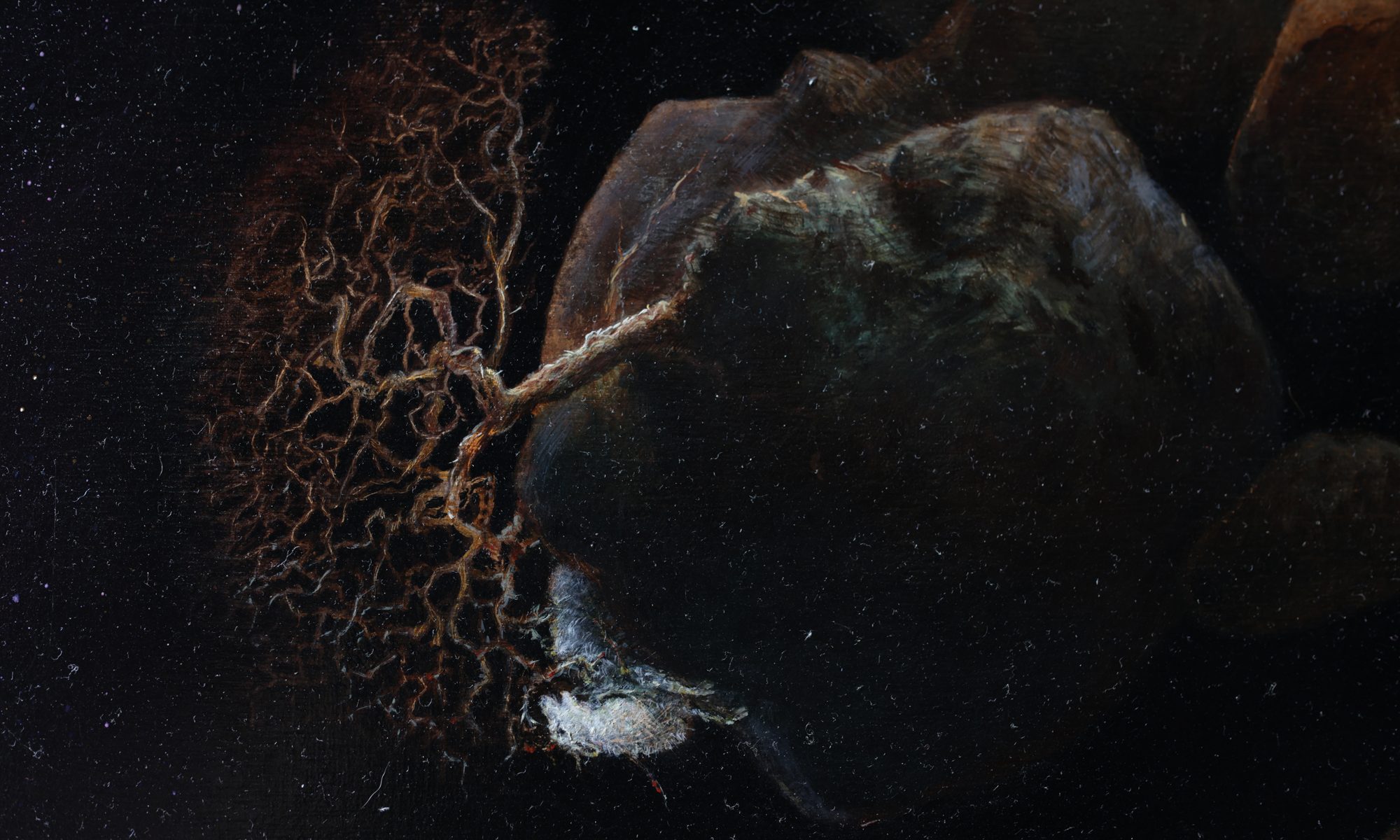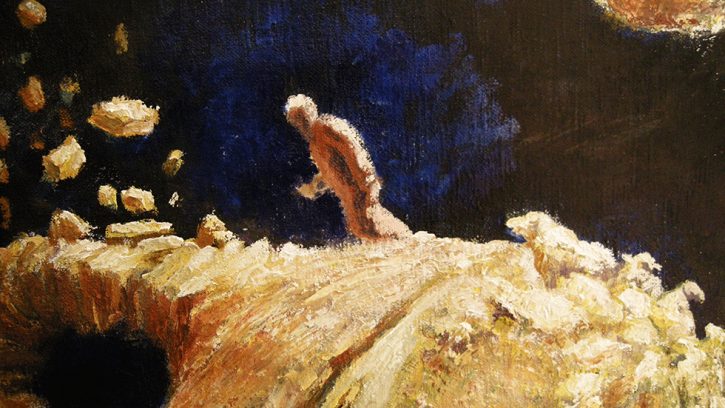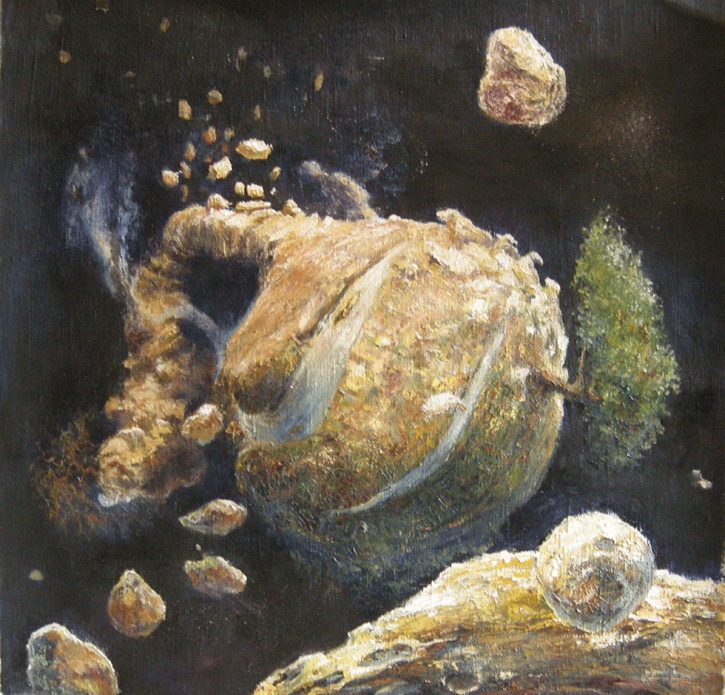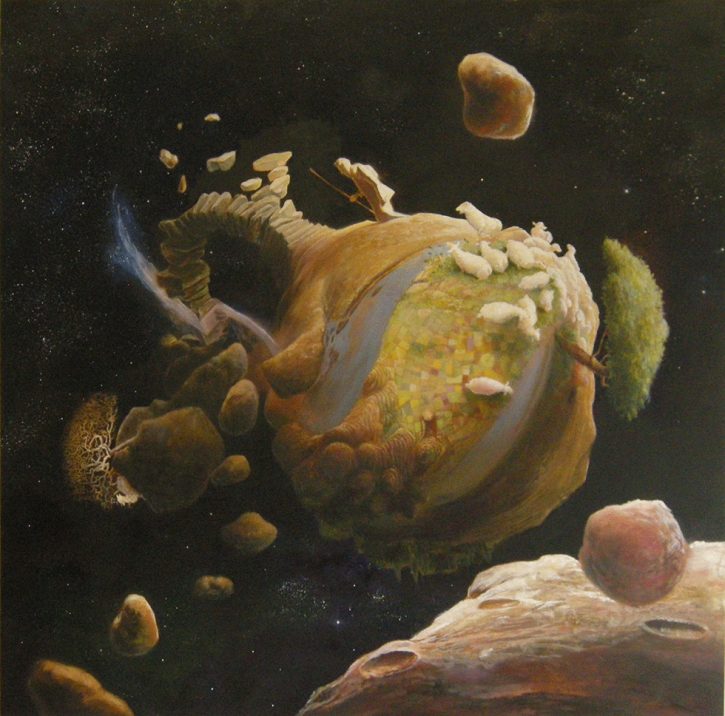Home » Multimedia Artwork » Parables » Good Shepherd Lost Sheep 2013

✢
Ancient prophets wrote that God made the earth, and stretched out the heavens (Jeremiah 10:12). God created all abstract form in sky, water, and soil, and from these layers, sheer mountains, gentle river valleys, pure water, complex ecosystems of living creatures. Scripture narrates how the first non-abstract image, the representation of objective truth–the person–was created in the image of God. Man and woman became the illustration of His Word.
Perhaps as with creation, so with the things humans craft. From a similar process of dividing and gathering, layers folding into layers and stretching out again, we get true swords, good bread, and rich wine. Purity in our world is something arrived at through a complex system of filters and transformations, pruning cuts and seasons of slow growth. A harmony emerges. Beauty radiates outwards, a movement through many layers. Maybe it is a process, or a moment within a grand process where the integrity, proportion, and consistency of those layers reveals we call in sum, beautiful.
Perhaps the first time I experienced beauty in process was in a drawing class. We were assigned a 4 week drawing, working from life, on a large piece of paper. I worked quickly, and after the first 4 hours, had something I was proud of. My teacher looked at the drawing silently, and then said, Why don’t you erase it and start over again. This happened 3 times—once each week. And though I lost every improvement I made with each revision, I learned through the erasures and through renewing my attempts at observation. The drawing (process) began to have a faint pulse of its own. It was a valuable lesson about what is good, what is true to life, what is beautiful, and what is valuable. A life lesson.
The more I learn about the craft of drawing and painting, the more awe I have within the process for the materials and the use of time. The more I rediscover the voice through the image I am working on, some sanctuary-like sense where beauty and strength reside, a deeper contemplation and a true, worshipful abandon echoes there.

✢
Here I want to describe a painting that came about in many layers. I will first show the layers of the process that lie beneath and around one painting, and then consider its content. It began originally as a small ink on paper illustration.
The next step involved a collaborative vision to redo the illustration as a larger painting in oil, and a pencil on paper sketch followed. This created a hopeful expectation, allowed the composition to settle, and relationships within the composition to form.
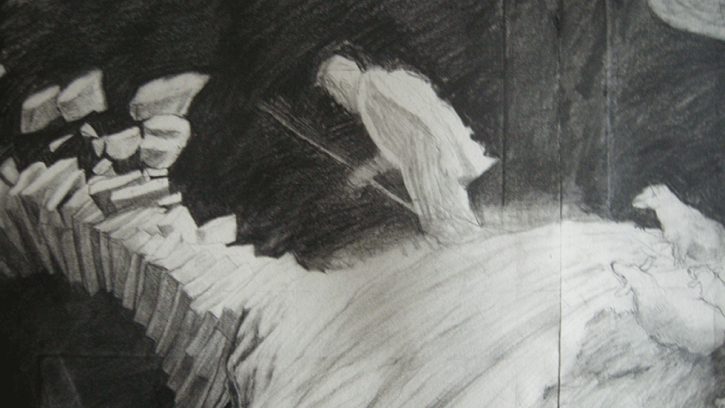
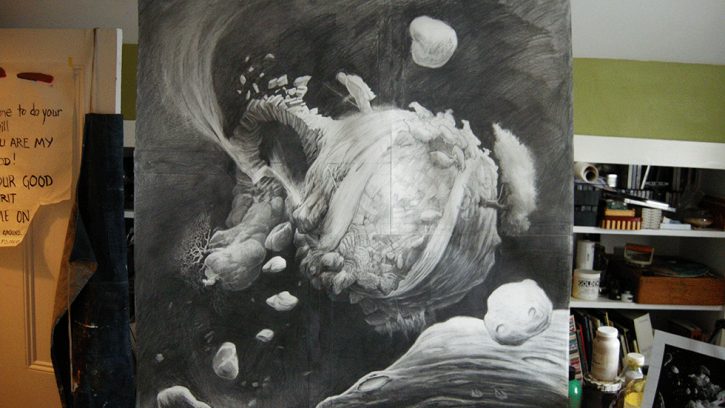
I then prepared a wood panel with traditional gesso, and reproduced the sketch on the panel as a line drawing. The line drawing on the panel became a value study in oil—umber and then sienna.


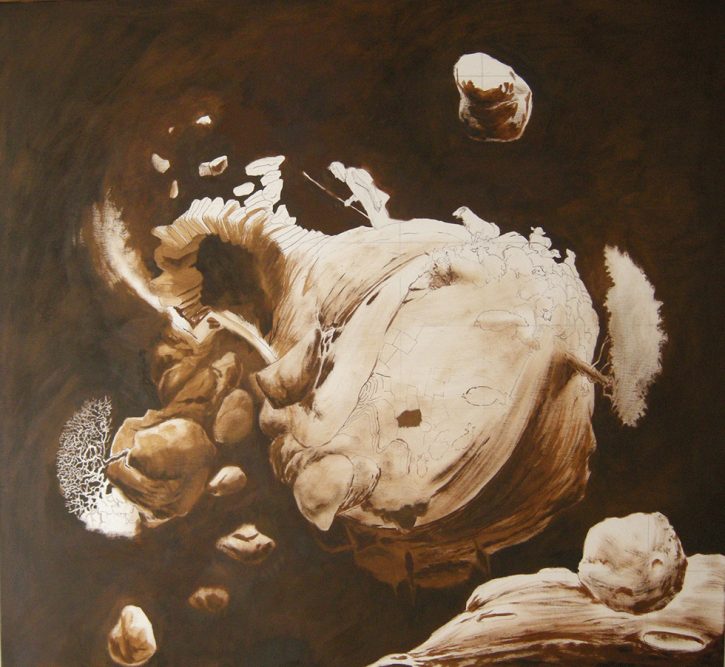
✢
At this point, before introducing color, I did separate paintings—a freehand color study with a palette knife on canvas at a slightly smaller scale, and various watercolors (not shown).
Having explored a bit, I returned to the panel and began laying in veils of color, and building in the details of what would become “The Good Shepherd and the Lost Sheep.”
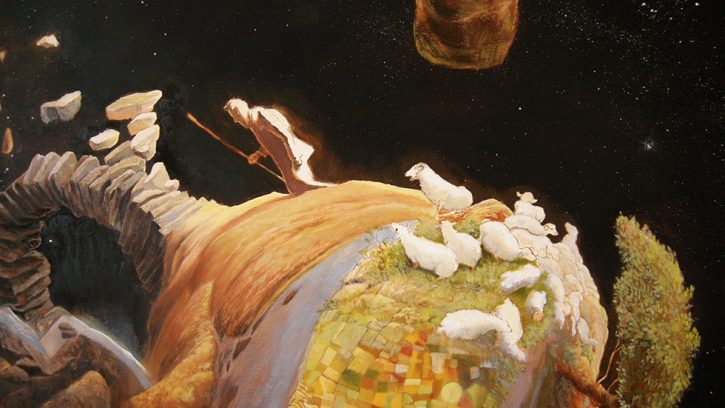
Good Shepherd Lost Sheep 2
Now, I’d like to dive back in and unfold some of the layers, as this painting is woven together from strands of many stories. The foremost is, of course, the parable that Jesus told to the Pharisees and scribes who were grumbling because so many tax collectors and sinners were coming to Him. They said, “This man receives sinners and eats with them.” In response, He told a parable. “What man of you, having a hundred sheep, if he has lost one of them, does not leave the ninety-nine in the open country and go after the one who is lost, until he finds it? And when he has found it, he lays it on his shoulders, rejoicing. And when he comes home, he calls together his friends and neighbors saying to them. ‘Rejoice with me, for I have found my sheep that was lost.’ Just so, I tell you, there will be more joy in heaven over one sinner who repents than over ninety-nine righteous persons who need no repentance.” (Luke 15:1-7)
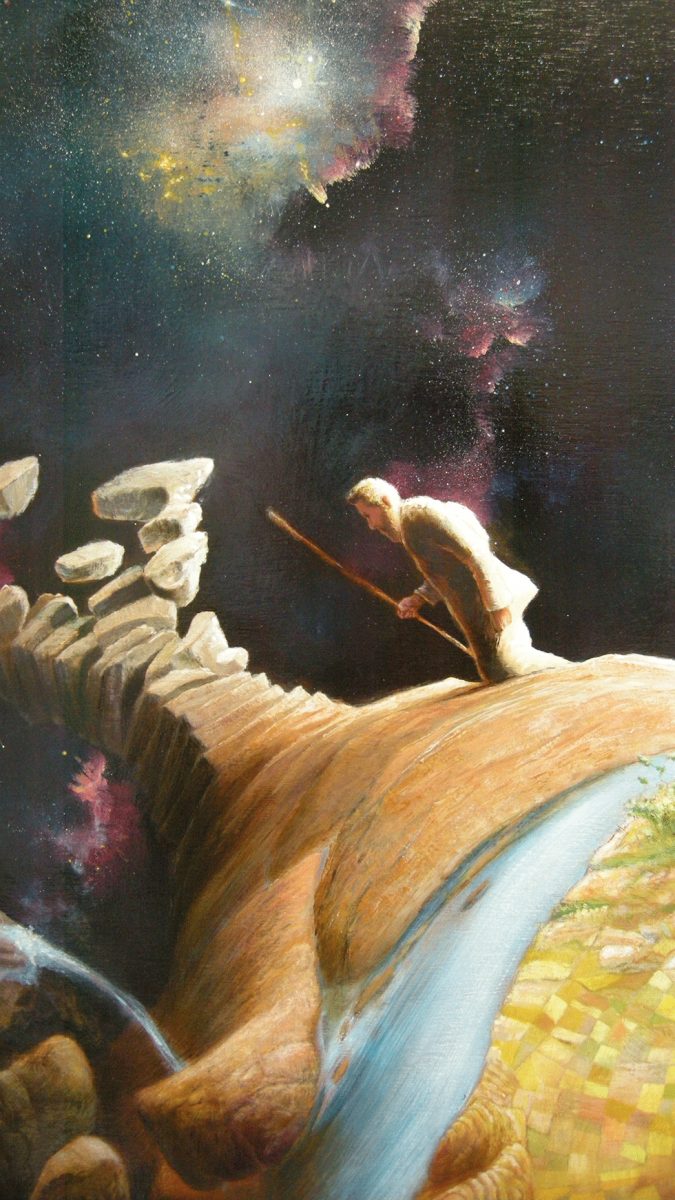
The painting shows the shepherd just setting out on His journey. The flock is safe in pasture, and yet incomplete. This lost sheep is counterpoint to the living tree planted near the pasture’s river, stranded on a barren rock, caught in the brambles of a thicket of dry thorns.
✢
In painting this painting, the book of Genesis provided an episode that added another critical dimension to this parable, and a deep plunge for our faith. When Abraham is commanded by God to offer Isaac, “his only son, whom he loves” (Gen. 22:2) as a burnt sacrifice, God provides a substitutionary offering. The picture of a ram caught by its horns in a thicket is rich with meaning. This ram is God’s provision to Abraham for the fulfillment of God’s demand, entangled among thorns, the curse of this world (Gen. 3:17-18). This picture calls to mind a thorn crowned Lamb, sacrificed by God’s design for all–tax collectors, sinners, scribes, and Pharisees alike.
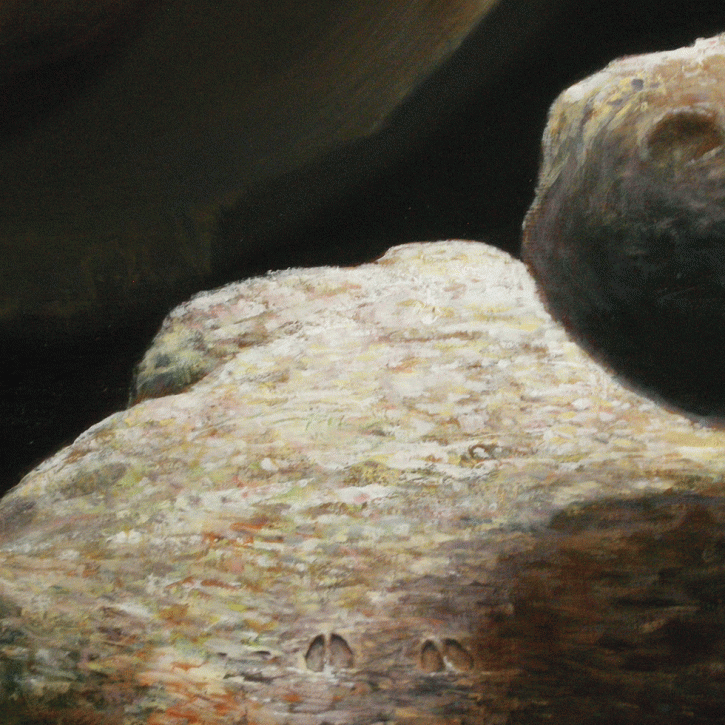
As I painted, turning again and again, to consider the words Jesus told in this parable, I began to glimpse the heart of God and man. Jesus, if taken at His word, is true God and true man, and reveals the Shepherd’s heart, giving us the opportunity to rejoice with him as friends and neighbors. But the Psalms give us the clearest view into the heart of the lost sheep through the last eight lines of Psalm 119, which all begin with the last letter of the Hebrew alphabet, ת (TAV):
Let my cry come before you, O LORD;
give me understanding according to your word!
Let my plea come before you;
deliver me according to your word.
My lips will pour forth praise,
for you teach me your statutes.
My tongue will sing of your word,
for all your commandments are right.
Let your hand be ready to help me,
for I have chosen your precepts.
I long for your salvation, O LORD,
and your law is my delight.
Let my soul live and praise you,
and let your rules help me.
I have gone astray like a lost sheep; seek your servant, for I do not forget your commandments.
Ps. 119:169-176
Interestingly, it is the lost sheep who is praying; the lost sheep who is praising God’s word, and singing; the lost sheep who is thirsting for God Himself; the lost sheep who cannot forget how completely he is dependent upon his Shepherd and Savior.
I hope this painting illuminates the journey of faith in the Shepherd, be it the faith of repentant sheep who are to be rescued, or that of chosen rams who are to be sacrificed. I hope it ultimately points back to the beautiful heart of Christ, who strayed far from his home for the sake of sinners.

✢


